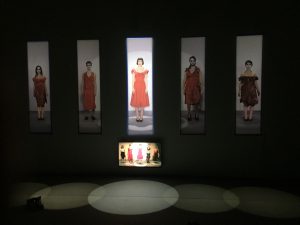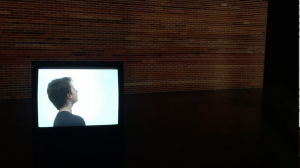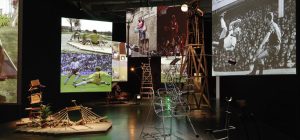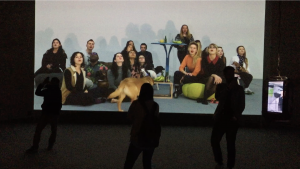
Over spring break I was fortunate to have the opportunity to visit one of my best friends in her place of residence, Paris. While there I dragged her to the many art museums and galleries the city had to offer.
Palais de Tokyo is a museum with a concentration on video art, installation, performance, and mixed-media. If the artist used a medium traditionally represented in art institutions, the artist transcended the form of the medium and used the medium’s base materials to address the formal qualities and assumptions of said medium. Another quality of this museum that I found antithetical to the typical credo of art institutions was an allowance for the viewer to come within close proximity of the piece. Pieces either had lenient boundaries or were constructed around the notion of audience interaction.
The most notable installation at Palais de Tokyo was a video, multi-media, and sculpture installation by Taro Izumi entitled Pan. This installation encompassed three large interlocking rooms. What especially struck me about this installation was how the three rooms interacted with each other both in terms of spatial and temporal relations. Even before walking through the dark entrance to the installation one already hears humans howling. The first thing one sees in the exhibit is a lone television screening a video of a boy standing in front of a white wall howling. He is but one of a chorus of howlers still to be found. Behind the television is a black wall with a projection of a cartoon brick wall flickering in and out.

The curiosity for the source of the other howls leads the installation into the room to the right monopolized by large-scale sculptures made from the essence of quotidian carpentry of chairs, stools and tables. These sculptures were made so a human could reenact spectacular feats by athletes. All sculptures were accompanied by a video projection of the iconic referential freeze frame moment and a moving image of a person enacting the freeze frame pose.

In the last, yet still very large, room the installation continues with many installations highlighted throughout the room leading the viewer on a calculated journey. Alas, the source of the greater howling is a large video projection of a group of people sitting directly in front of the camera howling in unison at random intervals. The installations, which peppered the room, were a basic equation of the installation in tangible form and a video, or sometimes multiple videos, playing on a television screen the documentation of the installation one is standing in front of. The main subject, a woman with a black bob, is absent from the actual installation but is present in the film. Her absence leads to the main thesis of this installation: a queering of time and space and the absence of the subject.

There were many smaller installations throughout this whole room which embodied an object representing the ghost of an action a human took. In the other half of the room, many neatly organized pairs of shoes were scattered. A large projection illustrated a collection of people standing in the spots occupied by the shoes. They were blindfolded and turned every time the subjects of the film threw a piece of fruit into a black hole full of ceramic shards.
Izumi is an artist who has spoken about his references to Beckett and absurdity coupled with a sense of humor. In this piece he also stated being interested in the “alliance of technology and the body perceived as a set of systems sketching new sensory spaces.” In this piece, Izumi sketches new sensory spaces by engaging the mind to depart from normal conventions of consuming art. In the sculptures, the subject would be highlighted in lieu of the pedestal. In this case, the subject is completely absent in concert with a video punctuating the subject’s absence. The negative space of the medium of sculptures was highlighted.

The installations engage the viewer on notions of time with an installation. The viewer can see the installation’s progress documented on screen by a group of people dressed as zombies; zombies serve as an on-the-nose reference to the art industry and the many hands involved with the making of, installation process, and representation of the artist’s “brand.” If the viewer transcends reality and Western notions of temporality, can the video documentation be seen as a chicken-egg scenario? Did the installation come first then the video or vice versa? The woman can also be seen as transcending time since she’s the subject in all videos allowing her to be present in many different places in one time.
Spatial and temporal relations are a constant with the overall installation since it’s disorienting nature directly confronts the viewers expectations on the relationship between logic and video. There is no beginning, middle and end relationship between all the videos. The howling videos also interact with each other between rooms helping the viewer to imagine themselves within the logic of the videos. Are we the subjects absent from the pieces? Able to roam free in the negative space beyond the hardware of the video monitors?
I was personally conflicted with this installation because I was captivated by the absurdity and lack of logic. However I’ve been lately wondering about the connection between conceptual art to bourgeois connoisseurship and capital. Can these installations only be appreciated by those who have the means to study these concepts, the time to see this exhibit, and the money to go to the museum (nevertheless the money to go to Paris)? Yet, paradoxically, I believe my Marxist or feminist inclinations can also be exclusionary and discriminating. Because although these concepts can be difficult to tease apart and outline, the basic premise of the piece can be felt. It’s very hard to confuse absurdity and a direct confrontation to an illogical reality. I honestly believe that the articulation of complicated concepts is not superior to any other form of intelligence. Concurrently, a lack of art theory does not negate a person’s opinion on the meaning of the piece. Even if a viewer can’t fully understand what they saw, they can still have an opinion on whether or not they enjoyed the piece and they can still emotionally connect to the piece.
I mean, I dragged my friend who doesn’t even like conceptual art to Palais de Tokyo and she got a kick out of the installations. She had multitudes of opinions about the male artist who was sitting on a dozen hen eggs in a plexi-glass box for three weeks (another discussion for another time!!)